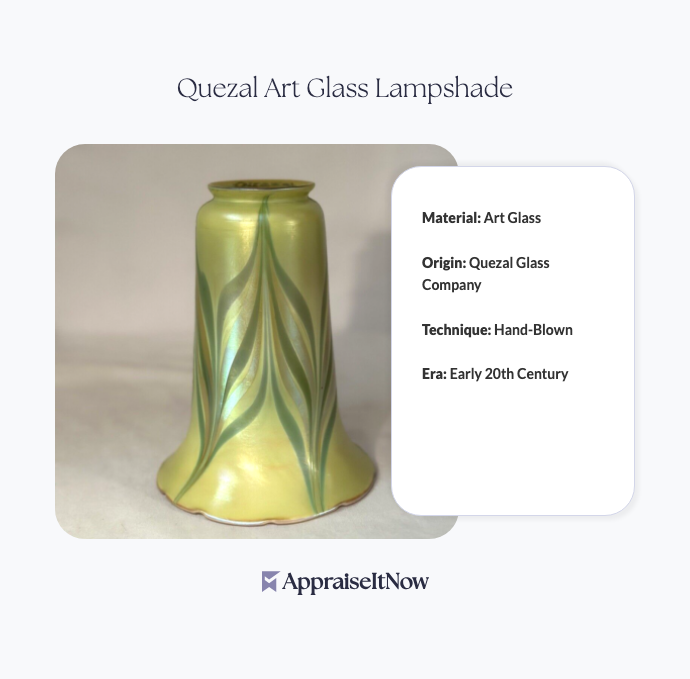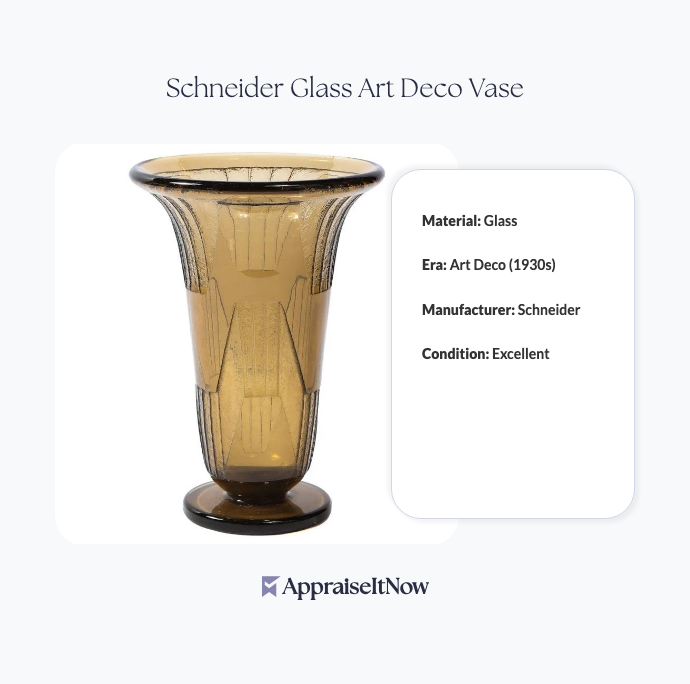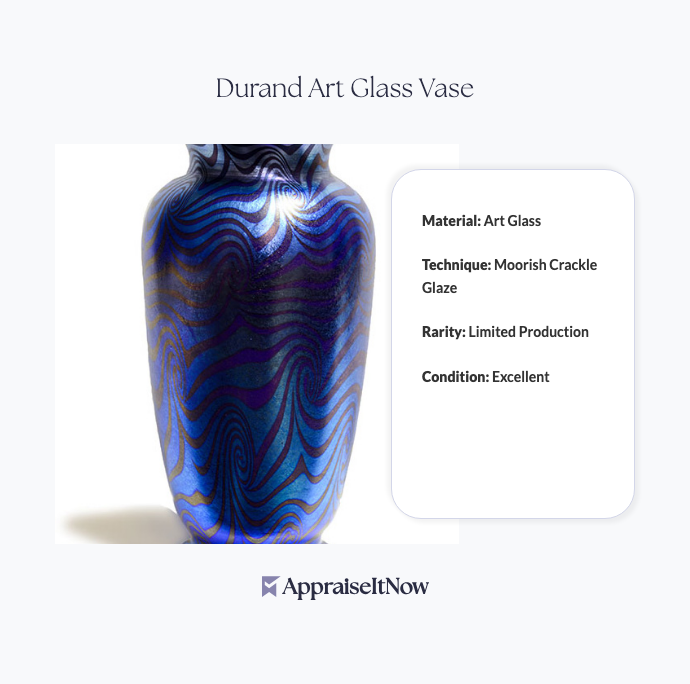<h1>How to Get Your Quezal Art Glass Lampshade Appraised</h1>
<p>If you own a Quezal art glass lampshade, you're in possession of a genuinely exceptional piece. These hand-blown creations from the early 20th century command strong market interest, with appraisal values typically ranging from <strong>$5,000 to $8,000</strong> depending on condition, rarity, and provenance. Whether you're planning to sell, insure, or simply document your collection, understanding how to navigate the appraisal process ensures you receive accurate valuation and professional documentation.</p>
<h2>Why Quezal Art Glass Lampshades Command Premium Values</h2>
<p>The Quezal Glass Company, established in the early 1900s, became renowned for pioneering revolutionary techniques in iridescent glass production. Your lampshade represents more than decorative lighting—it embodies the artisanal craftsmanship and innovation that defined the American Art Nouveau movement.</p>
<p>Each Quezal lampshade was hand-blown by skilled artisans using techniques that created the brand's signature vibrant, multi-colored iridescent finish. The company introduced its iconic designs around 1910 and maintained limited production numbers throughout its operation, which directly contributes to why collectors actively seek these pieces today. When evaluating <a href="/types/antique-artwork">antique artwork</a> and <a href="/blog/appraising-fine-glass-and-crystal-valuing-delicate-glassware-and-artistic-creations">fine glass pieces</a>, appraisers recognize Quezal as a historically significant manufacturer whose work commands respect in the decorative arts market.</p>
<div class="callout tip"><p><strong>Collector's Insight</strong></p>
<p>Quezal lampshades with documented exhibition histories or unusual color combinations can command premiums of 20-30% above standard market estimates.</p></div>
<h2>Authenticating Your Quezal Lampshade</h2>
<p>Before seeking professional appraisal, understanding how to identify genuine Quezal pieces helps you approach the process confidently. Authentic Quezal lampshades display specific characteristics that distinguish them from contemporaries like Tiffany, Loetz, or Steuben.</p>
<p>Genuine Quezal pieces typically bear the company's signature either etched, polished, or applied to the glass surface. The maker mark usually reads "Quezal" sometimes accompanied by "New York" or registered design numbers. However, some pieces lack visible signatures, particularly if the base was attached to a metal mounting that obscured the mark. Professional appraisers trained in <a href="/blog/what-do-appraisers-look-for-when-appraising-antique-artwork">antique glass authentication</a> know to examine the overall construction, glass composition, and design motifs to confirm authenticity even when signatures are absent.</p>
<p>The design language itself provides authentication clues. Quezal lampshades characteristically feature organic, flowing forms with pulled glass designs creating feather-like or vine patterns. The iridescent surface displays a distinctive shimmer shifting between gold, blue, green, and amber tones depending on light angle. These visual signatures result from Quezal's proprietary metallic oxide spray techniques applied during the glass-working process.</p>
<h2>Assessing Condition's Impact on Your Lampshade's Value</h2>
<p>Condition dramatically influences your Quezal lampshade's appraisal value. A piece in excellent condition with its original shade mount and no repairs might command the upper range of valuation ($7,000–$8,000), while examples showing wear, cracks, or repairs could fall to $4,000–$6,000.</p>
<p>Appraisers specifically evaluate chips along the rim or interior surfaces, as these are common damage points in vintage lampshades. Small surface chips may reduce value by 10–15%, while structural cracks compromising the shade's integrity can reduce value by 30–50%. Historical restoration work—particularly if poorly executed or using non-period-appropriate materials—typically decreases value substantially. Conservation-quality restoration by documented specialists, conversely, may impact value minimally if properly documented and reversible.</p>
<p>Fading of the iridescent surface, often occurring from prolonged light exposure, represents another condition factor. Original, vibrant coloration commands higher values than dulled or partially faded pieces. Your appraiser will assess whether any color loss is natural patina from age or indicates improper storage and handling.</p>
<div class="callout note"><p><strong>Professional Assessment</strong></p>
<p>Honest disclosure of all condition issues—cracks, repairs, missing components—actually strengthens your appraisal by establishing credibility and accurate fair market value documentation.</p></div>
<h2>Gathering Documentation and Provenance</h2>
<p>Your appraisal's credibility and your lampshade's value benefit significantly from documented ownership history. Provenance—the documented chain of ownership from creation through present day—influences both market value and collector desirability. A Quezal lampshade with documented exhibition history at prestigious institutions or provenance from recognized collectors commands premiums over unprovenanced examples.</p>
<p>Begin by collecting any documentation you possess: purchase receipts, auction house catalogs, insurance records, exhibition catalogs, or family correspondence discussing the piece's acquisition. Even informal documentation—a letter mentioning purchase date or previous owner—provides valuable context. Photograph your lampshade from multiple angles in natural light, capturing the signature area, any damage or repairs, and the overall form to provide your appraiser comprehensive visual documentation.</p>
<p>Understanding your piece's market positioning requires knowing comparable recent sales. Auction houses specializing in decorative arts regularly sell Quezal examples, and your appraiser will research these comparable transactions to establish fair market value. When you seek professional appraisal services, qualified experts access databases tracking auction results, private sales estimates, and dealer listings to position your specific lampshade within current market dynamics.</p>
<h2>Choosing the Right Appraisal Professional</h2>
<p>Not all appraisers possess equal expertise with Quezal glass and Art Nouveau-era decorative arts. The most reliable professionals hold credentials from recognized organizations like the <strong>American Society of Appraisers (ASA)</strong>, <strong>American Association of Appraisers (AAA)</strong>, <strong>International Society of Appraisers (ISA)</strong>, or <strong>Certified Appraisers Guild of America (CAGA)</strong>. These credentials indicate comprehensive training, adherence to USPAP (Uniform Standards of Professional Appraisal Practice), and ongoing continuing education in valuation methodology.</p>
<p>Ideally, your appraiser should demonstrate specific experience with American art glass, Art Nouveau decorative lighting, and early 20th-century glass manufacturing techniques. Ask potential appraisers about their experience appraising similar pieces and whether they maintain active involvement with dealer networks, auction houses, or museum collections where Quezal examples are regularly documented.</p>
<p>AppraiseItNow connects you with credentialed appraisers across the United States who specialize in <a href="/blog/appraising-antiques-unveiling-the-hidden-treasures-in-your-collection">decorative arts and antiques</a> valuation. Our network includes experts trained to distinguish Quezal from competitor glass studios and to evaluate condition factors that directly impact your lampshade's worth.</p>
<div class="callout tip"><p><strong>Selection Strategy</strong></p>
<p>Request sample appraisal reports from potential appraisers before engaging their services—their writing quality, detail level, and comparable sales documentation should meet professional standards.</p></div>
<h2>Understanding Value Standards for Your Purpose</h2>
<p>Professional appraisers recognize different value standards depending on your intended use. For insurance purposes, you typically need <strong>replacement value</strong>—the cost to replace your lampshade with a comparable example in today's market. Estate planning may require <strong>fair market value</strong>—the price at which your lampshade would change hands between a willing buyer and willing seller, neither under pressure.</p>
<p>If you're considering selling, <strong>liquidation value</strong> (what you'd likely receive through dealer sales or forced circumstances) typically runs 30–50% below fair market value, while specialized auction houses might achieve fair market value or higher depending on collector demand. Your appraiser should clarify which value standard applies to your situation and explain how that determination affects the final valuation.</p>
<p>The <strong>$5,000–$8,000 estimate</strong> typically reflects fair market value based on recent comparable sales. Your specific lampshade might fall within, above, or below this range depending on its individual characteristics—pattern rarity, color combination, condition, and provenance.</p>
<h2>Distinguishing Quezal from Contemporaries</h2>
<p>The early 20th-century art glass market included numerous accomplished manufacturers creating visually similar pieces. Your appraiser must distinguish Quezal from <strong>Tiffany</strong> (known for leaded glass construction and glass-metal integration), <strong>Loetz</strong> (Austrian maker producing similar iridescent effects but with different glass composition and design language), and <strong>Steuben</strong> (Corning's luxury brand with distinct manufacturing signatures).</p>
<p>This authentication work requires hands-on examination. Appraisers assess weight and glass thickness, examine how the shade connects to any original hardware, evaluate the specific iridescent color palette and intensity, and inspect manufacturing details revealing the production technique employed. Quezal's unique combination of thin, delicate glass with pronounced iridescent effects created through specific spray-application methods distinguishes it from other studios' products.</p>
<h2>Preparing Your Quezal Lampshade for Appraisal</h2>
<p>When you submit your lampshade for professional appraisal, provide high-quality photographs from multiple angles, including close-ups of any signatures, damage, or repairs. If the shade retains its original mount, document both the glass and metal components thoroughly. Include written description of the shade's dimensions, weight if you can determine it without risking the piece, estimated age based on your acquisition information, and any known history of repairs or restoration.</p>
<p>Avoid cleaning your lampshade before appraisal. Original patina and surface character, even subtle dulling or dust patterns, provide valuable information to experienced appraisers. Aggressive cleaning can inadvertently damage iridescent surfaces or remove subtle surface details that inform authenticity assessment.</p>
<h2>The Professional Appraisal Report</h2>
<p>Your completed appraisal should be a comprehensive USPAP-compliant document suitable for insurance, estate, legal, or sales purposes. The report establishes your lampshade's identification, condition assessment, comparable sales analysis, and the appraiser's value conclusion with clear supporting documentation. Quality appraisals include photographs, detailed condition descriptions, comparable sales citations, and the appraiser's credentials and statement of limiting conditions.</p>
<p>This formal documentation transforms your appraisal from casual opinion into professional evidence acceptable to insurance carriers, tax authorities, and courts. When seeking certified appraisal services, prioritize professionals who provide detailed written reports rather than verbal estimates—proper documentation protects your interests whether you're filing insurance claims, settling estates, or negotiating sales.</p>
<h2>Market Trends in Quezal Collecting</h2>
<p>Quezal art glass has appreciated steadily as collectors increasingly recognize the importance of American Art Nouveau designers and manufacturers. Museum acquisitions, auction house recognition, and dealer positioning have elevated Quezal's market profile significantly over the past decade. Your lampshade's value reflects this growing appreciation, with well-documented examples experiencing consistent demand.</p>
<p>Understanding current market dynamics helps you contextualize your appraisal value. Rare color combinations, unusual pattern variations, and pieces with exhibition or publication history command premium valuations. More common designs in good condition trade within standard market estimates. Your professional appraiser positions your specific piece within this market spectrum based on comparative sales analysis and collector demand assessment.</p>
<h2>Moving Forward with Confidence</h2>
<p>Whether you're insuring your Quezal lampshade, planning an estate, preparing for sale, or simply documenting your collection, professional appraisal provides the accurate valuation and authoritative documentation you need. The process requires qualified expertise, careful condition assessment, thorough market research, and clear communication—all delivered through credentialed appraisers trained in art glass valuation methodology.</p>
<div class="callout note"><p><strong>Key Takeaway</strong></p>
<p>A certified appraisal of your Quezal art glass lampshade delivers accurate fair market value documentation, professional authentication, and credible support for insurance, estate planning, or sales purposes. Connect with qualified appraisers experienced in American art glass to ensure your valuable piece receives proper expert assessment and documentation that protects your interests.</p></div>







.avif)







